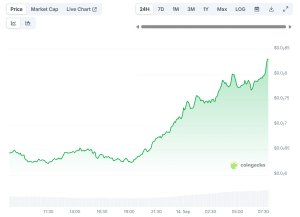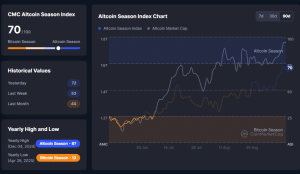PUMP, M, WLFI Soar As Official Altcoin Season Nears

Pump.fun, MemeCore, and World Liberty Financial led gainers as CoinMarketCap’s Altcoin Season Index closed in on an official altcoin season.
PUMP had jumped 29% as of 1:52 a.m. EST, extending its weekly gain to more than 70%, M added 10% for a weekly rise above 35%, and WLFI climbed 8% amid a token buyback and burn proposal.

PUMP price chart (Source: CoinGecko)
The strong 24-hour gains reflect growing momentum across altcoins, signaling that traders are rotating capital into smaller tokens ahead of a potential altcoin season.
TradingView data shows the altcoin sector’s market capitalization has surged more than 55% in the past month to $1.71 trillion after peaking at $1.74 trillion earlier in September.
Crypto Market Nears Altcoin Season
The gains seen by PUMP, M and WLFI comes with the CoinMarketCap Altcoin Season Index surging to 70 as it closes on the 75 level that confirms an official altcoin season.
Yesterday, the index reached a high of 72. Despite the slight pullback, the Index is still 17 points up from last week and 26 points up from a month ago, signaling that traders and investors in the market are growing increasingly confident that the next altcoin bull run is near.

CoinMarketCap Altcoin Season Index (Source: CoinMarketCap)
During the last 90 days, there have been some standout performers, with MYX exploding 12,399% and M skyrocketing 3,597%.
Commenting on the altcoin market’s recent performance, renowned trader and analyst Michael van de Poppe, who has more than 807k followers on X, said earlier in the month that the “uptrend on altcoins has started for the first time in 3 years.”
He added that the uptrend will continue for at least three months.
คุณอาจชอบเช่นกัน

Cryptocurrency Investment And Fiscal Policy

The US GENIUS stablecoin bill passed the Senate vote, but still needs the green light from the House of Representatives and the President. The Trump family stablecoin has become a controversial issue
